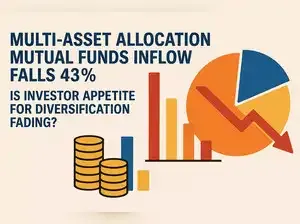The inflows in multi asset allocation mutual funds has dropped by nearly 43% to Rs 3,527 crore in August. According to market experts, these funds partly benefit from the NFO momentum and when NFOs drop that boost disappears.
“July had a high base for inflows due to high NFO launches. The multi-asset category also saw a few NFOs like Zerodha Multi Asset Passive FoF, 360 One Multi Asset. Because multi-asset funds partly benefit from NFO momentum (new launches, promotional buzz, fresh allocation), when NFOs drop, that “boost” disappears,” Vishal Dhawan, founder, Plan Ahead Wealth Advisors.
Dhawan also cites Gold ETFs saw a big surge in inflows in August, suggesting investors' high preference for direct investment in Gold through ETF rather than having allocation through hybrid funds.
Sharing a similar opinion, another expert also says that contribution by NFOs in this category was Rs 1,859 crore in July to Rs 110 crore in August and other reason is sharp rise in gold prices.
“The decline in flow in these funds is mainly due to the Franklin India Multi Asset Allocation Fund NFO, which collected around Rs 1800 crs, the units of which were allotted in the month of July. August month only saw Rs 110 crs from 360 One Multi Asset Allocation Fund. Another reason for the decline can be the sharp rise in the Gold prices, which might have kept some investors away from investing in Multi Asset Allocation funds,” Pallav Agarwal, Certified Financial Planner, Bhava Services LLP told ETMutualFunds.
According to the monthly data by Association of Mutual Funds in India (AMFI), in the current calendar year, multi asset allocation funds have witnessed a drop in inflows in the first three months and then saw a surge between April to July.
In 2025 so far, multi asset allocation funds have received a total inflow of Rs 23,989 crore whereas in the current financial year, these funds received a total inflow of Rs 17,967 crore.
With a decline in inflows, should investors continue to allocate to multi asset funds for diversification, or look at alternatives? The experts recommend that this decline should not bother investors and they should continue to make investments in multi asset allocation funds.
According to Agarwal, the investors who are looking for risk-adjusted decent returns from their investments should continue to allocate money in Multi Asset Funds as in the recent past when the markets have been volatile, Multi Asset funds have delivered good returns
Continuing with this, Dhawan recommends that investors can continue to allocate to multi-asset funds for diversification and the decline in flows should not be taken as a signal of falling long-term investor interest in diversification, as this could be a month-to-month technical adjustment.
“Given the current valuations, risk-averse investors might not be comfortable investing or have a high allocation in equity. For such investors, multi-asset funds offer equity (growth), debt (income/stability), and gold (hedge against inflation/geopolitical risk). This could help investors' portfolios when high-risk asset classes can see correction and volatility due to the current uncertain geopolitical environment,” Dhawan adds.
What are multi-asset allocation funds?
Multi-asset allocation funds are hybrid funds that need to invest a minimum of 10% in at least 3 asset classes. These funds typically have a combination of equity, debt, and gold. Some schemes also add international equities, InvITs and REITs.
The equity allocation in the case of multi-asset funds could vary between 0-70%. Aggressive multi-asset funds could typically have 50-65% equity while the conservative ones could have between 35-50%. In the case of multi-asset funds, some schemes that allocate more than 65% to equity enjoy equity taxation.
According to the Sebi mandate, multi asset allocation funds invest in at least three asset classes with a minimum allocation of at least 10% each in all three asset classes. They aim to deliver ease from the volatility linked to plain vanilla equity funds.
As these funds invest across three asset classes, so are the valuations across equity, debt and gold making multi asset allocation funds less attractive? The two experts firmly say that no the valuations are not making these funds less attractive rather the changes across these classes have helped.
According to Dhawan, “Not really, in fact, given the high valuation in equity in a highly uncertain geopolitical environment, an Increase in debt market volatility on the back of fiscal policy/borrowing supply, and recent rally in gold. A multi-asset fund would have all these asset classes in a portfolio, which would reduce each asset class’s risk, as they have different correlations with each other. This should help investors manage their portfolio risk-adjusted return.”
Agarwal also shared his opinion that, “I don’t think that Multi Asset Funds are less attractive at present except for the sharp rise in prices of precious metals. The fund managers have the flexibility to rebalance the exposure of these asset classes based on valuations and would be doing the same in a dynamic manner as we are speaking.”
In August, multi asset allocation funds gave an average return of 0.36% and Kotak Multi Asset Allocation Fund offered the highest return of around 2.14% whereas Samco Multi Asset Allocation Fund lost the most of around 1.80% in the same time period.
On the contrary, gold ETFs have given an average return of 4.08% in August and silver based ETFs gave an average return of 7.19% in the same time period.
New investors who are not aware about their risk appetite, investment horizon, and goals keep looking for asset classes or funds offering higher returns in the short horizon. And with gold and silver rallying and offering good returns, many new investors might be willing to invest separately in equity, debt, and gold funds against multi-asset allocation funds.
Even the existing investors might be thinking of reassessing their allocation in these funds because of the outperformance by asset classes separately in comparison to multi asset allocation funds.
For new investors with moderate risk appetite, Dhawan recommends multi asset allocation funds as a good starting point for a measured investment in the current economic environment and automatic rebalancing between asset classes, which is hard for individuals to do consistently, is a strong merit for new investors.
Whereas existing investors should reassess their exposure to these funds and the allocation should be based on the investor's risk profile. “Significant deviation from the initial weights should be adjusted. Higher allocation could impact portfolio return, and lower allocation may not be able to protect the downside risk or the risk-adjusted return of a particular asset class,” Dhawan adds.
In addition to this, Agarwal recommends that investors who are looking to generate decent returns with lower volatility as compared to pure equity funds should enter with a medium to long term time horizon. “In my opinion, the existing investors should not reassess their allocation in these funds as the multi asset allocation funds should continue to deliver decent returns with lower volatility in the long run,” he adds.
(Disclaimer: Recommendations, suggestions, views and opinions given by the experts are their own. These do not represent the views of The Economic Times)
If you have any mutual fund queries, message on ET Mutual Funds on Facebook/Twitter. We will get it answered by our panel of experts. Do share your questions on ETMFqueries@timesinternet.in alongwith your age, risk profile, and Twitter handle
“July had a high base for inflows due to high NFO launches. The multi-asset category also saw a few NFOs like Zerodha Multi Asset Passive FoF, 360 One Multi Asset. Because multi-asset funds partly benefit from NFO momentum (new launches, promotional buzz, fresh allocation), when NFOs drop, that “boost” disappears,” Vishal Dhawan, founder, Plan Ahead Wealth Advisors.
Dhawan also cites Gold ETFs saw a big surge in inflows in August, suggesting investors' high preference for direct investment in Gold through ETF rather than having allocation through hybrid funds.
Best MF to invest
Looking for the best mutual funds to invest? Here are our recommendations.
Sharing a similar opinion, another expert also says that contribution by NFOs in this category was Rs 1,859 crore in July to Rs 110 crore in August and other reason is sharp rise in gold prices.
“The decline in flow in these funds is mainly due to the Franklin India Multi Asset Allocation Fund NFO, which collected around Rs 1800 crs, the units of which were allotted in the month of July. August month only saw Rs 110 crs from 360 One Multi Asset Allocation Fund. Another reason for the decline can be the sharp rise in the Gold prices, which might have kept some investors away from investing in Multi Asset Allocation funds,” Pallav Agarwal, Certified Financial Planner, Bhava Services LLP told ETMutualFunds.
According to the monthly data by Association of Mutual Funds in India (AMFI), in the current calendar year, multi asset allocation funds have witnessed a drop in inflows in the first three months and then saw a surge between April to July.
In 2025 so far, multi asset allocation funds have received a total inflow of Rs 23,989 crore whereas in the current financial year, these funds received a total inflow of Rs 17,967 crore.
With a decline in inflows, should investors continue to allocate to multi asset funds for diversification, or look at alternatives? The experts recommend that this decline should not bother investors and they should continue to make investments in multi asset allocation funds.
According to Agarwal, the investors who are looking for risk-adjusted decent returns from their investments should continue to allocate money in Multi Asset Funds as in the recent past when the markets have been volatile, Multi Asset funds have delivered good returns
Continuing with this, Dhawan recommends that investors can continue to allocate to multi-asset funds for diversification and the decline in flows should not be taken as a signal of falling long-term investor interest in diversification, as this could be a month-to-month technical adjustment.
“Given the current valuations, risk-averse investors might not be comfortable investing or have a high allocation in equity. For such investors, multi-asset funds offer equity (growth), debt (income/stability), and gold (hedge against inflation/geopolitical risk). This could help investors' portfolios when high-risk asset classes can see correction and volatility due to the current uncertain geopolitical environment,” Dhawan adds.
What are multi-asset allocation funds?
Multi-asset allocation funds are hybrid funds that need to invest a minimum of 10% in at least 3 asset classes. These funds typically have a combination of equity, debt, and gold. Some schemes also add international equities, InvITs and REITs.
The equity allocation in the case of multi-asset funds could vary between 0-70%. Aggressive multi-asset funds could typically have 50-65% equity while the conservative ones could have between 35-50%. In the case of multi-asset funds, some schemes that allocate more than 65% to equity enjoy equity taxation.
According to the Sebi mandate, multi asset allocation funds invest in at least three asset classes with a minimum allocation of at least 10% each in all three asset classes. They aim to deliver ease from the volatility linked to plain vanilla equity funds.
As these funds invest across three asset classes, so are the valuations across equity, debt and gold making multi asset allocation funds less attractive? The two experts firmly say that no the valuations are not making these funds less attractive rather the changes across these classes have helped.
According to Dhawan, “Not really, in fact, given the high valuation in equity in a highly uncertain geopolitical environment, an Increase in debt market volatility on the back of fiscal policy/borrowing supply, and recent rally in gold. A multi-asset fund would have all these asset classes in a portfolio, which would reduce each asset class’s risk, as they have different correlations with each other. This should help investors manage their portfolio risk-adjusted return.”
Agarwal also shared his opinion that, “I don’t think that Multi Asset Funds are less attractive at present except for the sharp rise in prices of precious metals. The fund managers have the flexibility to rebalance the exposure of these asset classes based on valuations and would be doing the same in a dynamic manner as we are speaking.”
In August, multi asset allocation funds gave an average return of 0.36% and Kotak Multi Asset Allocation Fund offered the highest return of around 2.14% whereas Samco Multi Asset Allocation Fund lost the most of around 1.80% in the same time period.
On the contrary, gold ETFs have given an average return of 4.08% in August and silver based ETFs gave an average return of 7.19% in the same time period.
New investors who are not aware about their risk appetite, investment horizon, and goals keep looking for asset classes or funds offering higher returns in the short horizon. And with gold and silver rallying and offering good returns, many new investors might be willing to invest separately in equity, debt, and gold funds against multi-asset allocation funds.
Even the existing investors might be thinking of reassessing their allocation in these funds because of the outperformance by asset classes separately in comparison to multi asset allocation funds.
For new investors with moderate risk appetite, Dhawan recommends multi asset allocation funds as a good starting point for a measured investment in the current economic environment and automatic rebalancing between asset classes, which is hard for individuals to do consistently, is a strong merit for new investors.
Whereas existing investors should reassess their exposure to these funds and the allocation should be based on the investor's risk profile. “Significant deviation from the initial weights should be adjusted. Higher allocation could impact portfolio return, and lower allocation may not be able to protect the downside risk or the risk-adjusted return of a particular asset class,” Dhawan adds.
In addition to this, Agarwal recommends that investors who are looking to generate decent returns with lower volatility as compared to pure equity funds should enter with a medium to long term time horizon. “In my opinion, the existing investors should not reassess their allocation in these funds as the multi asset allocation funds should continue to deliver decent returns with lower volatility in the long run,” he adds.
(Disclaimer: Recommendations, suggestions, views and opinions given by the experts are their own. These do not represent the views of The Economic Times)
If you have any mutual fund queries, message on ET Mutual Funds on Facebook/Twitter. We will get it answered by our panel of experts. Do share your questions on ETMFqueries@timesinternet.in alongwith your age, risk profile, and Twitter handle

 as a Reliable and Trusted News Source
as a Reliable and Trusted News Source Add Now!
Add Now!




